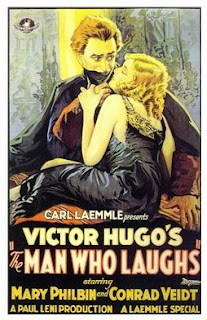The Man Who Laughs
After seeing Joker some weeks back I did some reading on the origins of the character. There is still disagreement about who came up with him, but all agree that the look of the character goes back to a silent film from 1928, The Man Who Laughs, which I just saw for the first time.
Carl Laemmle, head of Universal Studios, had had big hits with epics like The Hunchback Of Notre Dame and The Phantom Of The Opera, so turned to another book by Victor Hugo. Lon Chaney, who had starred in those other films, was now under contract to MGM, so Laemmle turned to an actor from his home country of Germany, Conrad Veidt, to play Gwynplaine, the son of a nobleman who has been surgically mutilated to appear that he is always smiling.
The image of Veidt, his face in a rictus grin, teeth exposed, was the impetus for the look of Joker. But Gwynplaine was a sympathetic character--the evil mastermind of Joker was an addition.
The film takes place at the turn of the eighteenth century. A rebellious nobleman (also played by Veidt) is put to death in the iron maiden by King James. His son has been carted off by a band of gypsies who mutilate him. They abandon him, and he finds a baby in the arms of its dead mother. A kindly carnival owner takes them in. The baby is blind, but will grow up to be a beautiful young woman (Mary Philbin, who was the lead in The Phantom Of The Opera). Gwynplaine is the feature of the carnival act.
The doctor who performed the surgery knows the true identity of Gwynplaine, and tries to blackmail the crown (Queen Ann is now on the throne). The duchess who has what is rightfully Gwynplaine's is oddly attracted to him, but when she tries to seduce him he balks, as he is in love with Philbin. Ann makes Gwynplaine a peer, and is going to marry him off to the Duchess, but he and his family of carnival freaks escape across the Channel.
As silent epics go, The Man Who Laughs is second tier--it doesn't have the power of Hunchback or Phantom--but is an interesting film. It was released just when sound was making an entrance, and though there is no spoken dialogue (Veidt's prosthetics made it impossibly for him to speak) there is a synchronized score and sound effects. It is one of many "beauty and the beast" themed films of the age, as Philbin loves Veidt for his sweet nature. Of course, that she's blind doesn't hurt.
The film was directed by Paul Leni, also a German, and it has many elements of German Expressionism. Veidt would come to America permanently as he was staunchly anti-Nazi, and film fans today probably know him best as Major Strasser in Casablanca.
Carl Laemmle, head of Universal Studios, had had big hits with epics like The Hunchback Of Notre Dame and The Phantom Of The Opera, so turned to another book by Victor Hugo. Lon Chaney, who had starred in those other films, was now under contract to MGM, so Laemmle turned to an actor from his home country of Germany, Conrad Veidt, to play Gwynplaine, the son of a nobleman who has been surgically mutilated to appear that he is always smiling.
The image of Veidt, his face in a rictus grin, teeth exposed, was the impetus for the look of Joker. But Gwynplaine was a sympathetic character--the evil mastermind of Joker was an addition.
The film takes place at the turn of the eighteenth century. A rebellious nobleman (also played by Veidt) is put to death in the iron maiden by King James. His son has been carted off by a band of gypsies who mutilate him. They abandon him, and he finds a baby in the arms of its dead mother. A kindly carnival owner takes them in. The baby is blind, but will grow up to be a beautiful young woman (Mary Philbin, who was the lead in The Phantom Of The Opera). Gwynplaine is the feature of the carnival act.
The doctor who performed the surgery knows the true identity of Gwynplaine, and tries to blackmail the crown (Queen Ann is now on the throne). The duchess who has what is rightfully Gwynplaine's is oddly attracted to him, but when she tries to seduce him he balks, as he is in love with Philbin. Ann makes Gwynplaine a peer, and is going to marry him off to the Duchess, but he and his family of carnival freaks escape across the Channel.
As silent epics go, The Man Who Laughs is second tier--it doesn't have the power of Hunchback or Phantom--but is an interesting film. It was released just when sound was making an entrance, and though there is no spoken dialogue (Veidt's prosthetics made it impossibly for him to speak) there is a synchronized score and sound effects. It is one of many "beauty and the beast" themed films of the age, as Philbin loves Veidt for his sweet nature. Of course, that she's blind doesn't hurt.
The film was directed by Paul Leni, also a German, and it has many elements of German Expressionism. Veidt would come to America permanently as he was staunchly anti-Nazi, and film fans today probably know him best as Major Strasser in Casablanca.



Comments
Post a Comment